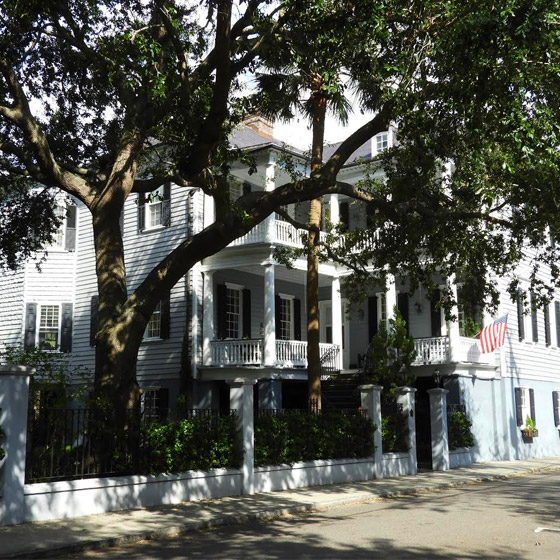
128 Tradd Street
Tradd Street spans the width of the peninsula; if there weren't any houses, you could probably stand in the center and see the Ashley River at one end and the Cooper River at the other end. Seeing 128 Tradd and the surrounding area today, it is difficult to imagine that when the house was built in 1765, it would have overlooked a creek and the marshes of the Ashley River.
On top of a raised brick basement, the exterior framework of the second and third floors is made of cypress wood, which is also extensively used in the interior. Cypress trees are native to the South Carolina lowcountry and easily obtained. More importantly, cypress is resistant to rot and discourages termites.
128 Tradd Street was the town home of English builder Humphrey Sommers. Sommers, who also owned two plantations outside of town, had become a wealthy man because of the quality of his building and contractor work and also from his extensive land holdings, which he'd built up over time. His home at 128 Tradd was constructed inside and out to reflect his wealth and status.
Sommers personally knew and had access to the best carvers in the area; after all, he was the chief subcontractor for the construction of St. Michael's Episcopal Church, completed in 1761, located at 80 Meeting Street. As a result, 128 Tradd has exquisite and ornate interior woodwork.
In fact, the woodwork in the second floor drawing room not only has a fireplace mantel, but also boasts an "overmantle" with a broken pediment that reaches close to the ceiling, all made of elaborately carved cypress. The woodwork in the bedrooms, by design, is not as ornate. In many houses of this era, the family rooms were relatively plain because only the family would see them. It is worth noting that the Museum of Early Southern Decorative Arts in Winston Salem, NC chose to reproduce the drawing room and a third floor bedroom of 128 Tradd as excellent examples of Charleston residential interior architecture of the pre-Revolutionary period.
In 1841, Judge Edward Frost purchased the property and made alterations to it (he later built 4 Logan from last week's post). 128 Tradd is still in the Frost family, but with a different last name, as the property passed through Frost's daughter. As with many of the historic Charleston houses that I've actually been in, 128 Tradd Street wears an invisible patina -- one that comes from being passed down through a family with its many memories and much love.
We'll continue visiting some of the many historic homes on Tradd Street over the next few posts.



